
NGC 27 is a spiral galaxy located in the constellation Andromeda. It was discovered on 3 August 1884 by Lewis Swift. It forms a galaxy pair with the nearby UGC 95.
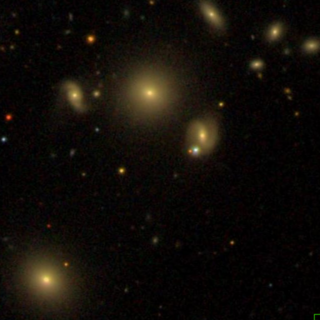
NGC 3553 is a lenticular galaxy in the constellation Ursa Major. It was discovered in March 1885 by Guillaume Bigourdan. It is a member of the galaxy cluster Abell 1185.

NGC 69 is a barred lenticular galaxy located in the constellation Andromeda. It is a member of the NGC 68 group. It was discovered in 1855 by R. J. Mitchell, who described it as "extremely faint, very small, round."

NGC 151 is a mid-sized barred spiral galaxy located in the constellation Cetus.

NGC 114 is a barred lenticular galaxy located in the constellation Cetus. It was discovered by American astronomer, Truman Henry Safford, on September 23, 1867. The galaxy lies approximately 195 million light-years from earth, and is about 55,000 light-years in diameter, nearly half the size of the Milky Way.
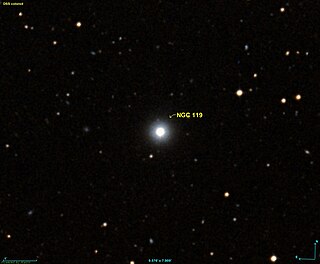
NGC 119 is an unbarred lenticular galaxy with an apparent magnitude of 13.0 located in the constellation Phoenix. It was discovered on October 28, 1834 by the astronomer John Herschel.

NGC 120 is a lenticular galaxy of type SB0? pec? with an apparent magnitude of 13.4 located in the constellation Cetus. It was discovered on 27 September 1880 by Wilhelm Tempel.

NGC 4500 is a barred spiral galaxy in the constellation Ursa Major. The galaxy was discovered on April 17, 1789 by William Herschel. It is a blue compact galaxy.
NGC 7199 is a barred spiral galaxy registered in the New General Catalogue. It is located in the direction of the Indus constellation. It was discovered by the English astronomer John Herschel in 1835 using a 47.5 cm reflector.

NGC 3001 is a magnitude 11.83 spiral galaxy in the constellation Antlia, discovered on 30 March 1835 by John Herschel. It has a recessional velocity of 2,465 kilometres (1,532 mi) per second, and is located around 115 million light years away. NGC 3001 has an apparent size of 4.3 by 3.1 arcminutes and is about 145 thousand light years across.
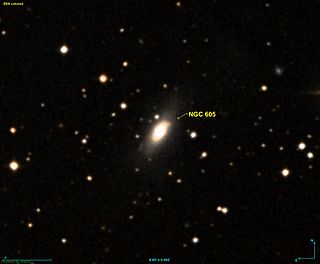
NGC 605 is a lenticular galaxy in the constellation Andromeda, which is about 234 million light-years from the Milky Way. It was discovered on October 21, 1881 by the French astronomer Édouard Jean-Marie Stephan.

NGC 995 is a lenticular galaxy located in the constellation Andromeda about 178 million light years from the Milky Way. It was discovered by the French astronomer Édouard Stephan in 1871.

NGC 903 is a lenticular galaxy in the constellation Aries. It is estimated to be about 230 million light-years from the Milky Way and has a diameter of approximately 35,000 ly. NGC 903 was on 13 December 1884 by the astronomer Edouard Stephan.
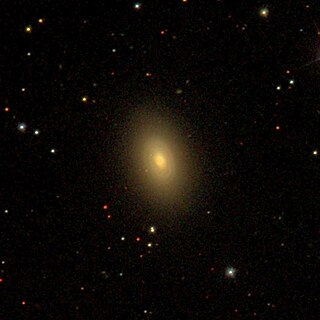
NGC 940 is a lenticular galaxy in constellation triangulum. It is estimated to be 222 million light-years from the Milky Way and has a diameter of approximately 80,000 ly. NGC 940 was discovered by Heinrich d'Arrest.
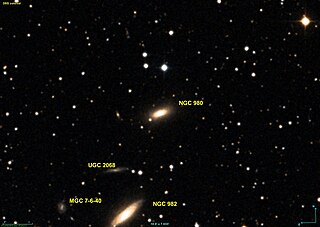
NGC 980 is a lenticular galaxy located in the constellation Andromeda about 256 million light years from the Milky Way. It was discovered by the German - British astronomer William Herschel in 1786.

NGC 814 is a lenticular galaxy in the constellation Cetus. It is estimated to be about 70 million light-years from the Milky Way and has a diameter of approximately 30,000 ly. NGC 814 was discovered on January 6, 1886 by the American astronomer Ormond Stone.

NGC 534 is a lenticular galaxy located in the constellation of Sculptor about 260 million light years from the Milky Way. It was discovered by the British astronomer John Herschel in 1835.

NGC 823, also known as IC 1782, is an unbarred lenticular galaxy in the constellation Fornax. It is estimated to be 194 million light-years from the Milky Way and has a diameter of approximately 100,000 light years. NGC 823 was discovered on October 14, 1830 by astronomer John Herschel.

NGC 2803, also known as PCG 26181, is an elliptical or lenticular galaxy in the zodiac constellation Cancer. It was discovered March 21, 1784, by William Herschel. It is interacting with NGC 2802.

NGC 3156 is a lenticular galaxy located in the constellation Sextans. It is located at a distance of about 75 million light-years from Earth and is forming a pair with NGC 3169. It was discovered by astronomer William Herschel on October 13, 1784.
![]() 01h 19m 59.595s, +14° 47′ 10.40″
01h 19m 59.595s, +14° 47′ 10.40″ 



















